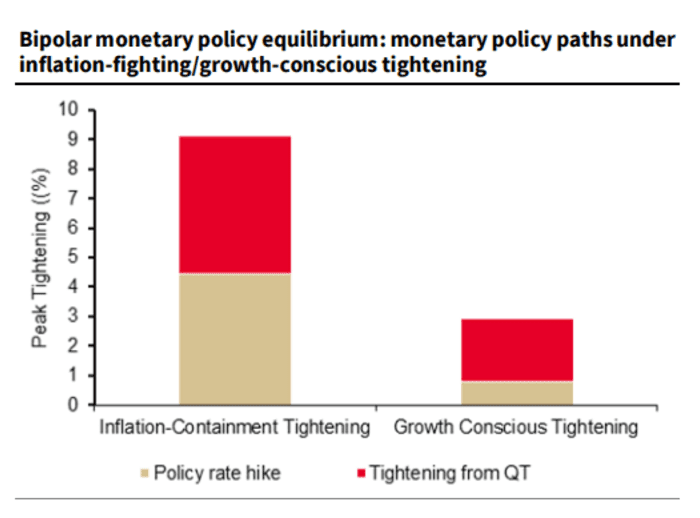This post was originally published on this site
Federal Reserve Chairman Jerome Powell has begun talking about a “softish landing” for the economy as the central bank squares off against high inflation by raising rates and cutting its nearly $9 trillion balance sheet.
But what if Powell instead retraces the policy steps of former Fed Chair Paul Volcker from 40 years ago in a quest to stamp out inflation, for good, even at the cost of an economic recession?
That’s a scenario that Societe Generale’s global quantitative research team studied in a client note Tuesday, now that an “inflation-fighting impulse” is in the air. The team, led by the French bank’s head of North American quant research Solomon Tadesse, concluded that it could take another 9.25% (see chart) of monetary-policy tightening to stamp out inflation, should the Fed adopt a sole focus on containing inflation.

What a Volcker-style inflation fight could require 40 years later.
Societe Generale Quant Research
“Given that rates have already been tightened by 2.5%, another 9.25% of monetary tightening might be expected via policy rate hikes and an aggressive QT program,” the team wrote.
Specifically, that could mean a policy rate increase of 4.5% overall, plus a roughly $3.9 trillion reduction of its balance sheet, known as quantitative tightening, or “roughly equivalent to the net growth of the Fed’s balance sheet during the pandemic.”
On the flip side, if the Fed goes after a “growth-conscious tightening” cycle, one that aims to avoid a hard landing, the team sees little room left to tighten. In that scenario, policy is seen as peaking after 3% additional tightening, broken down into $1.8 trillion in balance-sheet reduction and only a further 25 to 50 basis points of rate hikes.
Stocks have fallen sharply this year as the Fed has looked to cool inflation near levels last seen in the early 1980s. The S&P 500 index
SPX,
was down 14.2% in 2022 through Tuesday, while the Dow Jones Industrial Average
DJIA,
was 10.1% lower and the Nasdaq Composite Index
COMP,
was down 23.4% for the same stretch.
“Should supply-chain bottlenecks ease over time, the degree of monetary tightening needed to contain inflation through demand destruction could turn out to be lower,” the Societe Generale team wrote.

